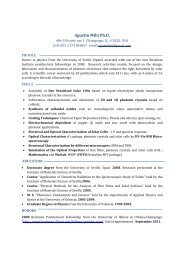A Self-Healing Conductive Ink - Paul Braun Research Group ...
A Self-Healing Conductive Ink - Paul Braun Research Group ...
A Self-Healing Conductive Ink - Paul Braun Research Group ...
You also want an ePaper? Increase the reach of your titles
YUMPU automatically turns print PDFs into web optimized ePapers that Google loves.
COMMUNICATION<br />
2<br />
www.advmat.de<br />
Figure 1 . Representation of self-healing silver particle sample a) before damage, b) immediately<br />
after damage, showing solvent release from microcapsules, and c) after healing, where<br />
the majority of solvent has evaporated. d) 3D representation of sample used for scratch testing.<br />
e) Top and f) side geometries of samples with dimensions shown. (Samples are not not drawn<br />
to scale.)<br />
Figure 2 . Characterization of conductive ink and microcapsules. Optical micrograph of<br />
scratched silver ink circuits on a glass slide a) before damage and b) after a drop of solvent<br />
was added to the scratch and was allowed to evaporate. c) SEM image of polyurea/polyurea–<br />
formaldehyde (PU/PUF) microcapsules containing hexyl acetate with average diameter of<br />
192 μ m. d) SEM image of silver particles from the commercially available conductive ink.<br />
wileyonlinelibrary.com<br />
© 2012 WILEY-VCH Verlag GmbH & Co. KGaA, Weinheim<br />
www.MaterialsViews.com<br />
ability of solvent to enable reorganization of<br />
the conductive particles. In the healed line, a<br />
scar from the original scratch is visible, yet<br />
an intact conductive pathway was formed.<br />
To extend these screening tests to a fully<br />
autonomic healing system, we included coreshell<br />
microcapsules ( Figure 2 c and Supporting<br />
Information (SI), Figure S1a) to supply solvent<br />
to the conductive ink (see conductive ink<br />
particles in Figure 2 d). Our design consists<br />
of silver particle ink lines deposited onto a<br />
plastic substrate with solvent-fi lled microcapsules<br />
incorporated into a polyurethane layer<br />
deposited atop the silver ink line ( Figure 1 a).<br />
Failure of the circuit via mechanical damage<br />
simultaneously releases solvent from the<br />
microcapsules ( Figure 1 b). By the mechanism<br />
described in the screening tests, released<br />
solvent locally dissolves the poly mer binder,<br />
allowing the immobilized silver particles to<br />
redistribute and form a connected pathway<br />
once the solvent evaporates ( Figure 1 c), thus<br />
restoring electrical conductivity.<br />
We previously reported the preparation<br />
of hexyl acetate microcapsules [ 29 ] and chose<br />
to use this solvent because of its lower toxicity<br />
and affi nity to dissolve the polymeric<br />
binder. We used a procedure optimized for<br />
solvent encapsulation [ 30 ] to prepare the capsules<br />
for this application. After fi ltration and<br />
drying, we sieved the capsules to isolate those<br />
ranging from 180–250 μ m in diameter. The<br />
polyurethane layer, which is deposited over<br />
the ink line, contained hexyl acetate microcapsules<br />
for self-healing specimens or, as a<br />
control, no microcapsules (see Figure 1 d–f<br />
for substrate geometry).<br />
To measure conductivity during damage<br />
and in the initial minutes after damage, we<br />
connected the silver ink line to a Wheatstone<br />
bridge via lead wires. For testing over hours<br />
or days, we measured the resistance using<br />
an ohmmeter. We used scratch damage to<br />
approximate stress-induced cracking. To<br />
mechanically damage the samples, a razor<br />
blade was used to apply scratches to the circuits,<br />
causing all samples to fail electrically.<br />
Scanning electron microscopy (SEM) analysis<br />
(SI, Figure S3) shows that the scratch<br />
extends through the conductive ink and into<br />
the underlying plastic substrate. For concentrations<br />
of capsules in the polyurethane layer<br />
between 10 and 30 wt%, a decrease in sample<br />
resistance was observed within 1–10 min<br />
( Figure 3 a and SI, Figure S4). None of the<br />
control samples without microcapsules<br />
regained conductivity. We tested the conductivity<br />
restoration when the voltage was<br />
not actively monitored, and we found that<br />
Adv. Mater. 2012,<br />
DOI: 10.1002/adma.201200196




